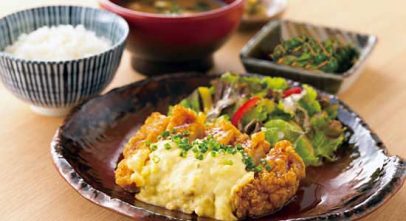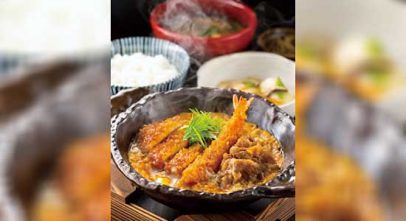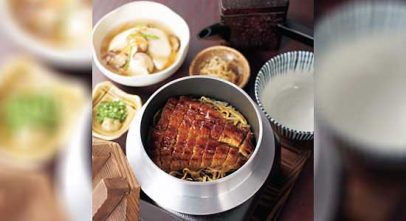News
New Japanese restaurant serves special rice
November 22, 2016
HOME TO MANY food inventions (square watermelons, anyone?) it isn’t surprising to learn that Japan has also produced a gourmet specialty rice that tastes like white rice but is as healthy as brown.
 ALL SERVED on a bed on Kinmemai rice: Chicken namban, a set meal of chicken steak with
ALL SERVED on a bed on Kinmemai rice: Chicken namban, a set meal of chicken steak with
special sauce, miso soup, a side dish, and rice.
 ALL SERVED on a bed on Kinmemai rice: Mix teishoku,
ALL SERVED on a bed on Kinmemai rice: Mix teishoku,
which includes pork loin, fried shrimp, sukiyaki, and beef.
 ALL SERVED on a bed on Kinmemai rice: Hitsumabushi,
ALL SERVED on a bed on Kinmemai rice: Hitsumabushi,
a grilled eel dish that comes with instructions on the ritual of eating it.
Japan’s Kinmemai rice is produced through a cleaning method that polishes the rice while maintaining its nutritional value. Kinmemai rice tastes and looks like the beloved white rice but it has the benefits of the brown rice, including more fiber and protein.
The specialty rice, which, according to a friend who lives in Japan, costs ¥1,500 to ¥2,000 or P706 to P941 for a two-kilo bag, is only available in Japan — except if one happens to dine in a Japanese restaurant chain which has just opened a branch in Metro Manila.
The newly opened restaurant at Mandaluyong’s SM Megamall B is called Yayoi, a teishoku eatery. Teishoku is a set meal that honors the Japanese’ tradition of well-balanced dining: a bowl of hot rice, a miso soup, a vegetable side dish and tsukemono (Japanese pickles), and an entree of meat or fish.
Yayoi (pronounced “yayowee”) is an old restaurant chain, having first opened in Tokyo in 1886, and has since expanded far and wide. As of 2014, Yayoi had 274 restaurants in Japan, 129 branches in Thailand, six in Singapore, and one each in Australia and Taiwan. In the Philippines, Yayoi is set to open 15 branches in the next five years and the second branch will open early next year at the SM Mall of Asia in Pasay City.
Yayoi Philippines’ managing director Yvonne Yao told BusinessWorld on Sept. 15 that her family discovered the restaurant while on vacation in Fukuoka, Japan last year. It was late and the rest of the restaurants were closed except for Yayoi, which was just a stone’s throw away from their hotel. “We tried it and immediately fell in love,” the 24-year-old young entrepreneur said. (Her father is Emerson Yao, Lucerne group managing director.)
The ingredients used in the Philippine restaurant are from Japan, and the dining experience is the same as what one will find in the Land of the Rising Sun’s branches where diners order via an iPad menu. The preparation and ingredients are authentic but the taste of the dishes has been altered according to cater to the Filipino palate, which is less salty and sweeter, said Ms. Yao.
The special lunch for the media highlighted five of Yayoi’s best-sellers across all its branches abroad. All the dishes sit on a bed of hot Kinmemai rice, including the namban (chicken steak), sukiyaki (a sweet soup of meat, tofu, vegetables, and noodles in a hot pot), saba shio (grilled salted mackerel), mix toji (pork loin, fried shrimp, sukiyaki, and beef), and hitsumabushi (grilled eel).
A special instruction card is given to diners who order hitsumabushi which notes that the diner should mix everything together and then divide it into four portions, each of which will be treated in a different manner. For the first partition, diners are told to put the hitsumabushi in a separate torizara (serving saucer) and eat it as it is. Once they are finished, they should move on to the second portion: they are told to again place the portion in the torizara, but this time mix it with a mixture of wasabi (Japan’s famed green spicy condiment) and spring onion. The third portion (placed in the same torizara) is to be mixed with ochazuke dashi (a broth) for a porridge-like consistency. The treatment of the last portion is left up to the diner: eat it as it is, mix it with wasabi, or with broth.
The restaurant also offers a kid’s meal: mini servings of udon (noodles), fried chicken, breaded prawn, tomatoes, rice corn, edamame (soybean), orange juice, and a cup of ice cream at P280.
But the rice is the story. It could be a meal on itself. It is heavy like brown rice (this writer did not eat dinner after finishing a namban meal at 2 p.m.) but looks as white and tastes as good as the white rice Filipinos grew up with. The cup of Kinmemai rice is sweet and sticky. Because the rice is a premium product, Yayoi does not offer unlimited servings, but it does not matter because one teishoku is both filling and fulfilling.
The menu prices range from P120 (an order of edamame) to P665 (a deluxe meal, like teriyaki salmon and pork cutlet), which is quite affordable to think that each teishoku set meal is served on a bed of super rice. — Nickky Faustine P. de Guzman
SOURCE: http://www.bworldonline.com/content.php?section=Arts&Leisure&title=new-japanese-restaurant-serves-special-rice&id=133748
